There are a few things that are important to Americans – high heat, high horsepower and linear acceleration. And once you want to mix these things, they have a collective name – muscle car. Interestingly, Americans are willing to pay more than half a century of hard work to build a car, and its name is “Corvette”.


The first generation Corvette (1953-1962) “solid shaft” Supercar.
Corvette was inspired by Harley Earl, the first chief designer of General Motors. In the early 1950s, the light and flexible performance of the European sports car caught his attention. It was said that he was highly respected for the Jaguar XK120. In June 1952, executives passed the “Opel Sports Car” project to manufacture a two-seat sports car which make by fiberglass composite body. Just five months later, the first Corvette, code-named EX-122, appeared in New York.

The first generation of Corvette was dubbed the “solid shaft”, which originated from the design of the C1 non-independent rear suspension. The white convertible version of 1953 only produced 300 cars by hand. The 1955 version also offers a 4.3-liter V8 engine as an option based on the standard “Blue Flame” straight 6 engine. Due to the huge horsepower of the two engines, the early C1 could only be equipped with a two-speed automatic transmission.
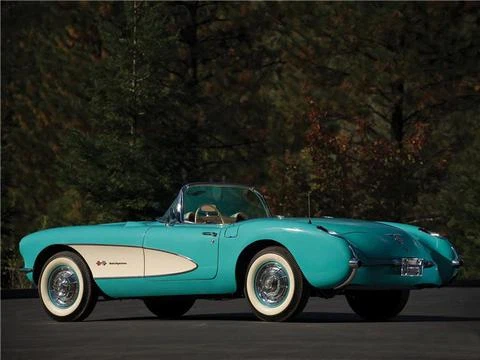
Starting from the appearance of the 1956 version of Corvette, the sports car constantly made changes on machinery. First, with the new front face and side panels, Earl’s classic “double tail” taillights also disappeared. In the 1957 version, a fuel injection system became an option, and this engine became the first mass-produced V8 engine in history to achieve more than 1 horsepower per cubic inch (about 46 kW/L). In the past two years, electric windows, hydraulic canopies, 4-speed manual transmissions, and new brake and suspension systems have also appeared on the C1.
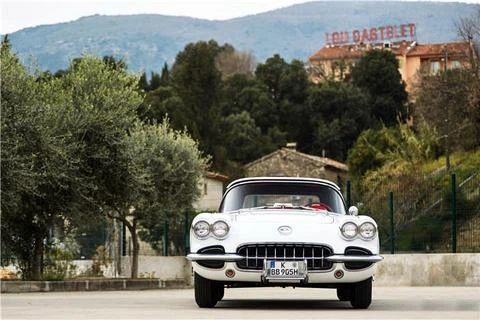
 Later, between 1958 and 1960, the C1 made a more luxurious and comfortable change in the interior. The tail of the 1961 version of the C1 was redesigned, and the duck-tailed tail with four round headlights became the unchanging element of Corvette. In the 1962 version, the previous small-cylinder V8 engine was expanded to 5.4 liters, producing an amazing 340 horsepower, making it the fastest C1 version, and it became the highest accomplishments of C1 Corvette with only a convertible body and a non-independent rear suspension.
Later, between 1958 and 1960, the C1 made a more luxurious and comfortable change in the interior. The tail of the 1961 version of the C1 was redesigned, and the duck-tailed tail with four round headlights became the unchanging element of Corvette. In the 1962 version, the previous small-cylinder V8 engine was expanded to 5.4 liters, producing an amazing 340 horsepower, making it the fastest C1 version, and it became the highest accomplishments of C1 Corvette with only a convertible body and a non-independent rear suspension.
The second generation of Corvette (1963-1967) is a veritable “new generation”.

Known as the second generation “Sting Ray” Corvette C2, is considered by many fans to be the most fascinating model. The car’s unique exterior design comes from a previous concept called “Q Corvette” car. In addition to this inspiration, there was the commemorative model “Mitchell Sting Ray” designed by the then design director Bill Michelle in 1959 for the Chevrolet exiting the factory and a mackerel shark he caught while fishing in the deep sea.
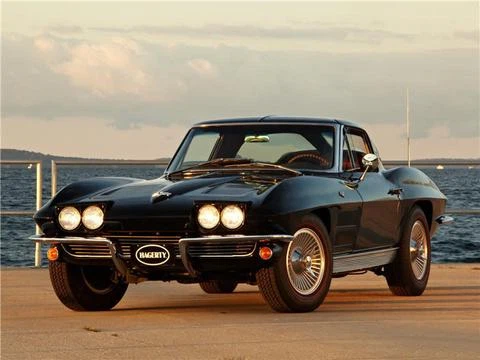
Production of the C2 version began in 1963. The first version of the C2 has a pointed tail, hidden headlights, an independent rear suspension that says goodbye to the “solid shaft” era, and later became the classic split tail window and decorative air intake. Due to the engineer of “The Father of Corvette”, Zola Akostentov, did not like the split tail window that affected the line of sight, so the design that was loved by the fans lasted only one year and disappeared on the C2 of the 1964 version.

The 1967 Sting Ray was the last version of the C2. The vents on the hood reappeared. The rectangular reversing lights were placed in the middle of the car tail. The 4 red taillights that appeared frequently in later versions were used for the first time. This version of C2 introduced the 430-horsepower L88 engine for the first time, and then introduced the experimental Pontiac 427 L89 engine. Despite the great efforts in power, the sales of C2 dropped by about 15 %.

 In addition to the production car being relished by the fans, the Lightweight racing version of Grand Sport Corvette, which was launched by Chief Engineer Akostentov in 1962, is also a classic. At the time, in order to compete with Ford’s Shelby Cobra, GM plans to produce 100 Grand Sports, but eventually produced only five. But the only five cars have continued to obtain much achievement under the driving of many legendary racers. Today, the five cars numbered 001 to 005 are privately owned and become one of the most valuable models of Corvette.
In addition to the production car being relished by the fans, the Lightweight racing version of Grand Sport Corvette, which was launched by Chief Engineer Akostentov in 1962, is also a classic. At the time, in order to compete with Ford’s Shelby Cobra, GM plans to produce 100 Grand Sports, but eventually produced only five. But the only five cars have continued to obtain much achievement under the driving of many legendary racers. Today, the five cars numbered 001 to 005 are privately owned and become one of the most valuable models of Corvette.
The third generation Corvette (1968-1982), the guided car on the Indy 500 circuit.

The appearance of the third generation Corvette C3 comes from the concept car “Mako Shark II” inspired by the basking shark. The T-shaped removable roof design is reproduced in later versions of the LT-1, ZR-1 and Collector Edition. Production of C3 continued from 1968 to 1982.
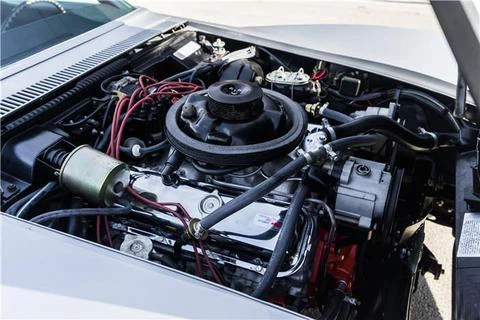
Most of the C3’s engine and chassis inherit the C2’s settings, but with a new body and interior. In terms of powertrain, the 5.7-liter engine was replaced by a 5.4-liter version, but the power of 300 hp did not decrease. In 1969, the C3 was equipped with the new all-aluminum large-cylinder engine ZL-1. Its official power data was 430 hp, but the civil test reached 560 hp, which made the C3 equipped with this engine ran a staggering 10.89 seconds in the 1/4 mile straight-line acceleration game.
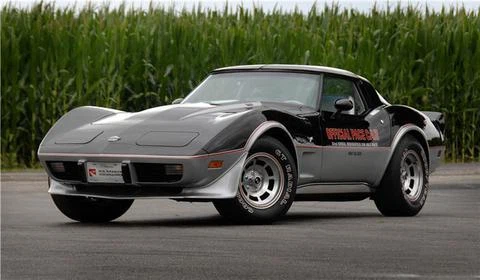
In 1978, Corvette’s 25th Anniversary Edition introduced a design of back-sliding rear window and a new interior and dashboard. This commemorative version has launched the Indy 500 limited edition and silver anniversary edition. It was these two cars that made Corvette the first guide car to the Indy 500 race.
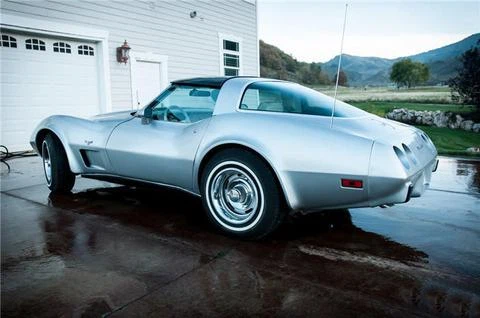
 The 1979 version of the C3 uses the seat design of the guided vehicle and uses the front and rear spoiler as an option. A year later, Corvette integrates the aerodynamic test to redesigned the body and reduced weight on the chassis and body, which greatly increased the speed. In 1982, a fuel injection engine returned, and the last C3 collector’s edition with an open sliding back window was officially launched.
The 1979 version of the C3 uses the seat design of the guided vehicle and uses the front and rear spoiler as an option. A year later, Corvette integrates the aerodynamic test to redesigned the body and reduced weight on the chassis and body, which greatly increased the speed. In 1982, a fuel injection engine returned, and the last C3 collector’s edition with an open sliding back window was officially launched.
After the first three generations of turbulence, from the fourth generation, Corvette officially embarked on the fast lane of the performance car. In addition to the big change in power, the emergence of transmissions and more high-performance versions also indicates that the American supercar dream has begun to ferment.
The fourth generation Corvette (1984-1996), power exchange.
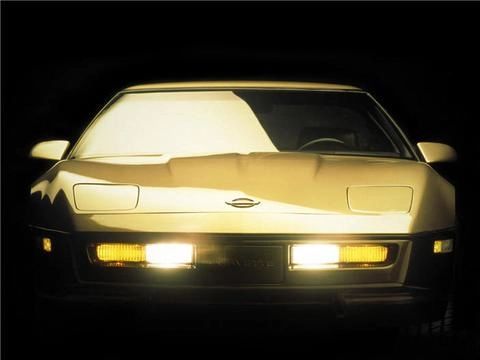
The fourth generation of Corvette is the first brand new Corvette since the appearance of C2 in 1963, and its birth is quite tortuous. The C4 was originally planned to be launched in 1983, but due to quality problems, only 44 prototypes of the 1983 version were built but not sold. All cars in this version were later destroyed, and only one white body, blue interior prototype car was kept in the Corvette National Museum in Pauling Green, Kentucky.
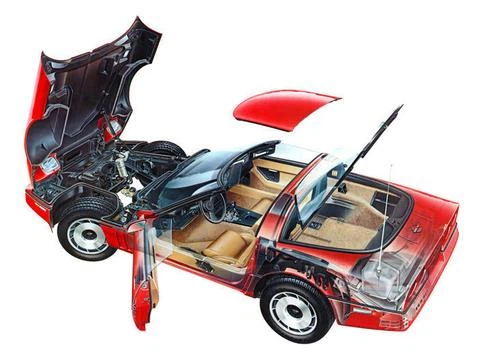
Compared to the previous version, the initial version of the C4 is powered by a 5.7-liter L83 “Crossfire” V8 engine that adds 5 horsepower. New chassis features include all-aluminum brake calipers and all-aluminum suspension, which greatly reduces weight and enhances chassis stiffness. The new car roof has no C3 open a middle seam design. For the interior, the LCD digital code meter and tachometer on the electronic instrument panel are standard. Since 1985, the standard engine has been changed to a 230 hp L98 engine with a fuel injection system.

It is worth mentioning that between 1984 and 1988, Corvette provided a set of “4+3” transmissions designed by Doug Nash. The principle is a four-speed manual transmission combined with an automatic transmission with three overdrives. This design helped C4 meet US fuel economy standards, but soon the design was found to be flawed. So since 1989, it has been replaced by the advanced ZF 6-speed manual transmission.
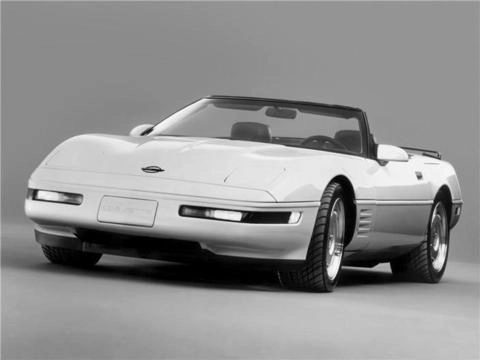
 In 1987, a new twin-turbo powertrain B2K became an option. The so-called Callaway version of Corvette is a version with B2K. As an excellent power solution, the early B2K had 345 horsepower and 610 Nm of torque, while the later version broke out with an amazing 450 horsepower and 831 Nm of torque. By 1992, the 300-horsepower LT1 engine became the standard engine, which was a full of 50 horsepower more than the 1991 L98 engine. The drive wheel anti-skid system ASR is also present in this version, which can control the power by using brakes, time delay ignition and throttle closing, preventing the rear wheels from idling and ensuring handling. However, drivers who are unwilling to be driven by it can also turn it off at any time to enjoy more wild power.
In 1987, a new twin-turbo powertrain B2K became an option. The so-called Callaway version of Corvette is a version with B2K. As an excellent power solution, the early B2K had 345 horsepower and 610 Nm of torque, while the later version broke out with an amazing 450 horsepower and 831 Nm of torque. By 1992, the 300-horsepower LT1 engine became the standard engine, which was a full of 50 horsepower more than the 1991 L98 engine. The drive wheel anti-skid system ASR is also present in this version, which can control the power by using brakes, time delay ignition and throttle closing, preventing the rear wheels from idling and ensuring handling. However, drivers who are unwilling to be driven by it can also turn it off at any time to enjoy more wild power.
The fifth generation of Corvette (1997-2004) takes advantage of Japanese sports cars

After C4, Chevrolet once again created a Corvette equipped with the highest technological crystallization at that time. It is this C5 that enabled GM to successfully enter the 24 Hours of Le Mans and the Le Mans Series. The appearance of such a car is inseparable from the car commentators of the C4 era. At that time, many car reviews made Corvette compare with Japanese cars and put forward a lot of criticism. As a result, Chevrolet used the classic Japanese car Nissan 300ZX and Mazda RX-7 as the benchmark for styling and quality, and created this C5, which is considered to have achieved unprecedented improvement in every aspect.
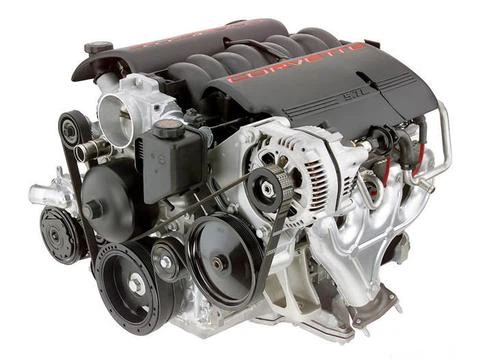
 Interestingly, along with the C5, GM’s new LS1 small cylinder V8 engine, the third generation of the small cylinder, was completely redesigned: it has an all-aluminum cylinder, a distributorless ignition system and a new ignition program. This engine, combined with the new car’s drag coefficient as low as 0.29, makes this new car can reach 8.4L fuel consumption of 100 kilometers on the highway.
Interestingly, along with the C5, GM’s new LS1 small cylinder V8 engine, the third generation of the small cylinder, was completely redesigned: it has an all-aluminum cylinder, a distributorless ignition system and a new ignition program. This engine, combined with the new car’s drag coefficient as low as 0.29, makes this new car can reach 8.4L fuel consumption of 100 kilometers on the highway.
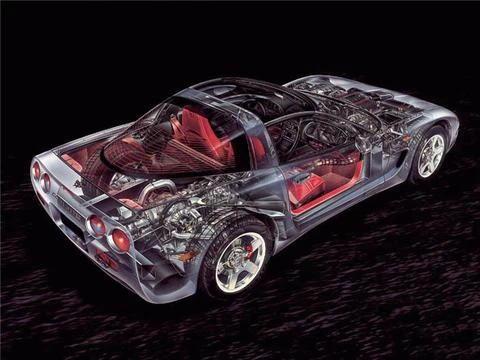
There is also a brand new design on the C5. The previous Corvettes were the direct connection of the gearbox to the engine, and this version placed the gearbox above the rear axle, effectively compensating for the weight of the engine on the front axle. This radical design like the Porsche 928 became the new transmission design feature of Corvette.

In the first year of C5 production, only the version of the coupe was introduced, then the fixed top double door version (FRC version) was introduced in 1999. One of the reasons for the birth of the FRC version is that Corvette wants to try a lite version car with a V6 engine, which successfully paved the way for the Z06 that emerged in 2001.
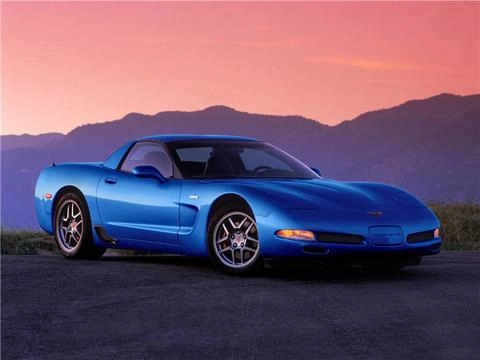
As a high-performance version of the C5, the Z06 version eliminates the heavy double overhead camshaft engine setting like the ZR-1 in the fourth generation. It uses a 385-horsepower LS6 engine derived from the basic engine LS1. With a more rigid roof and upgraded brakes, the Z06’s maneuverability is greatly enhanced. The application of some new materials, such as the exhaust system of titanium alloy and the carbon fiber hood, has greatly reduced the weight of the car. Although the Z06 has the same power rating as the C4 version of the ZR-1, the new suspension, brakes, increased stiffness and lightweight body make the Z06 a leader in speed.
After entering the 21st century, Corvette finally began to have the appearance of “European car”. While pursuing large displacement and high horsepower, it also began to shift its focus to control. Especially in the C7 generation, Corvette has almost completely separated from the “stupid, big, fast” Slogan.
The sixth generation of Corvette (2005-2012) is the product of the new century.
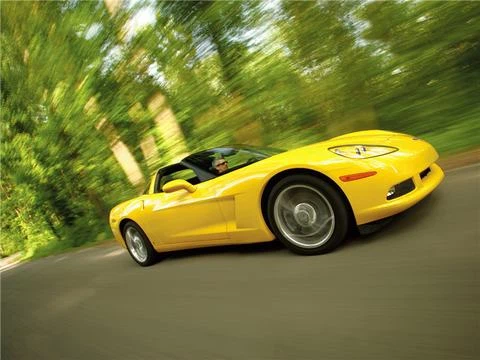
The C6 continues the rear-mounted layout of the C5 gearbox, but in addition to its new body adds many new elements: new headlights, larger crew compartment, a new 6.0-litre engine and re-geometry-tuned suspension. Although it has a larger wheelbase than the C5, the longer and wider body does not seem to attract too many customers in the European market. The engine’s 6.0-liter LS2 V8 engine delivers 400 horsepower and 575 Nm of torque, which makes the C6’s 100-kilometer acceleration time less than 4.2 seconds.
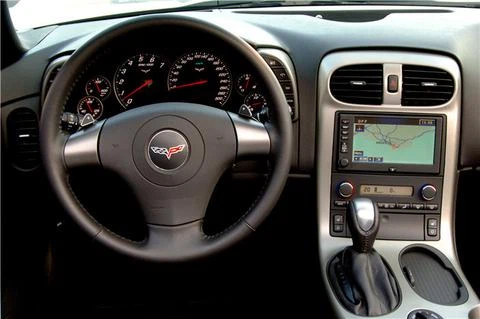
The C6 maintains a relatively good fuel economy of C5, achieving a fuel consumption of 9L per 100 km. This is due to its 0.28 drag coefficient and lighter kerb mass, as well as, as well as a gearbox with a Computer Aided Gear Selection (CAGS) system. The reduction in fuel consumption has also saved C6 from the high oil tax in the United States.
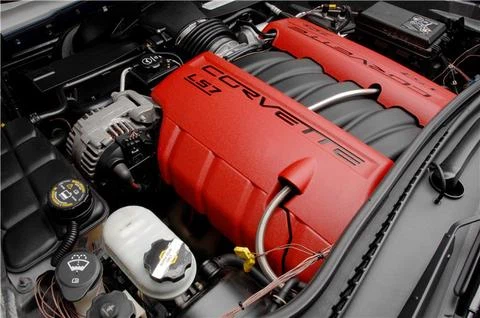
The new Z06 high-performance version was launched in the third quarter of 2005 and is equipped with a 7.0L version of the small cylinder V8 engine, numbered LS7. This is also the GM’s largest small cylinder V8 official data is 505 horsepower, 100 km acceleration time 3.8 seconds, the top speed 319km / h.

 For the C6, another high-performance version of the ZR1, General Motors announced in 2007, through the designed for the ZR1 with an Eaton-supercharged 6.2L engine “LS9”, which has reached the goal of raising hundreds of powers. In other words, this engine can emit amazing energy that more than 620 horsepower (data is 638 horses, 819 cattle • meter)! The speed of this super muscle car has also reached a height of 330km / h.
For the C6, another high-performance version of the ZR1, General Motors announced in 2007, through the designed for the ZR1 with an Eaton-supercharged 6.2L engine “LS9”, which has reached the goal of raising hundreds of powers. In other words, this engine can emit amazing energy that more than 620 horsepower (data is 638 horses, 819 cattle • meter)! The speed of this super muscle car has also reached a height of 330km / h.
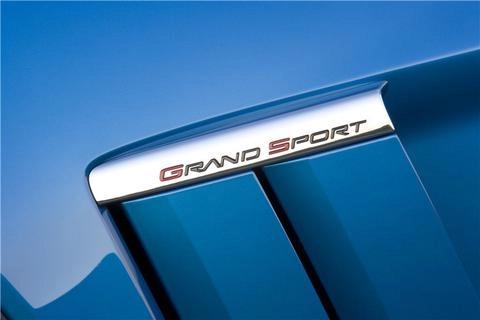
 In 2010, Grand Sport, a historical classic, was re-launched as a replacement for the Z51 version. The basic version is powered by the LS3 engine with many Z06 versions’ configure: the top 18 and rear 19 tires, the dry sump, the front 6-cylinder rear 4-cylinder 14-inch brake disc, the reinforced suspension and the carbon fiber front panel.
In 2010, Grand Sport, a historical classic, was re-launched as a replacement for the Z51 version. The basic version is powered by the LS3 engine with many Z06 versions’ configure: the top 18 and rear 19 tires, the dry sump, the front 6-cylinder rear 4-cylinder 14-inch brake disc, the reinforced suspension and the carbon fiber front panel.

In 2012, Corvette launched the Centennial version of the Z06 and the convertible version 427 of the Z06. Just like the commemorative version that was released before the end of each generation, the launch of these two versions is a perfect ending for the C6’s “career”. It also opened the curtain for the arrival of C7.
The seventh generation Corvette (2013-present) was grew out of Le Mans.
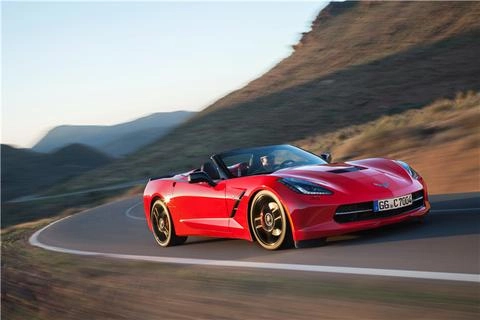
At the 2013 North American Auto Show, the new generation Corvette C7 was officially released. The C7 is based on the C6R, which is the Chevrolet’s previous generation Corvette Le Mans. The new framed pure aluminum chassis Heavily use lightweight design (45 kg weight reduction), including a carbon fiber hood and a removable top cover. The composite material is used for the doors and fenders (17 kg weight reduction), so the weight of the whole vehicle is lower and the fuel economy is naturally better.

The C7 still uses the layout of the front and rear drive. The engine uses the 6.2-liter LT1 series naturally aspirated V8 engine, which has an actual displacement of 6,162 cc, a maximum output of 450 hp and a maximum output torque of 610 Nm. Especially at 2,000-4,000 rpm, it can delivers 542 Nm of torque, so its acceleration performance is excellent. The acceleration time of 100 kilometers is less than 4 seconds. The engine part also corresponds to fuel direct injection, continuously variable valve timing and other technologies, its fuel economy has increased by 13%, while the fuel consumption in the constant speed mode is as low as 9.6 liters per 100 kilometers, which is absolutely for a super sports car. It is a surprising achievement.
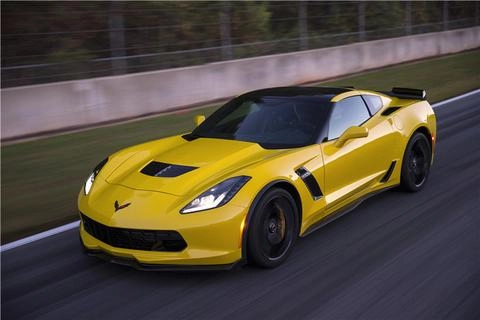
 A year later, the Corvette Z06 also ushered in a comprehensive upgrade. Unlike the ordinary C7, the Z06 was developed in conjunction with the latest Corvette Le Mans C7R, which uses the same chassis. The C7 Z06 is powered by Chevrolet’s newly developed LT4 6.2L V8 supercharged OHV engine, which is based on the C7’s LT1 and is hand-built with a maximum horsepower of 650 and a maximum torque of 881 Nm.
A year later, the Corvette Z06 also ushered in a comprehensive upgrade. Unlike the ordinary C7, the Z06 was developed in conjunction with the latest Corvette Le Mans C7R, which uses the same chassis. The C7 Z06 is powered by Chevrolet’s newly developed LT4 6.2L V8 supercharged OHV engine, which is based on the C7’s LT1 and is hand-built with a maximum horsepower of 650 and a maximum torque of 881 Nm.

Compared to the C6 ZR’s LS9 engine, the LT4 abandoned the R2300 supercharger used in the LS9 and replaced it with the Eaton R1740TVS supercharger. Its supercharger speed was increased from 15080 rpm to 20150 rpm. Compared to the C6 ZR’s LS9 engine, the LT4 abandoned the R2300 supercharger used in the LS9 and replaced it with the Eaton R1740TVS supercharger. Its supercharger speed was increased from 15080 rpm to 20150 rpm. The diameter and length of the rotor are shortened by 11 mm, and the distance between the two rotors is also shortened by 8 mm. In addition, the volume of the intercooler has been greatly reduced, and the overall engine weight has been reduced from 240 kg of the LS9 to 230 kg.
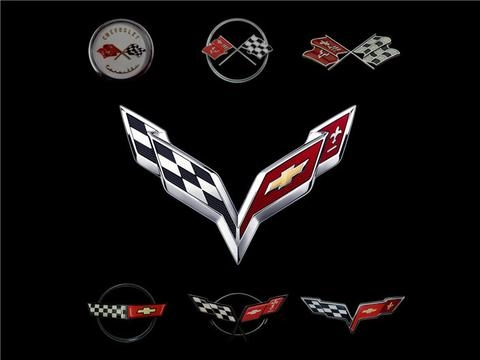
As for when the next generation C8 model will be available? I think it shouldn’t be too long, but the engine layout we are familiar with may be replaced by a mid-mounted rear drive. But how about it, it is always Corvette!
